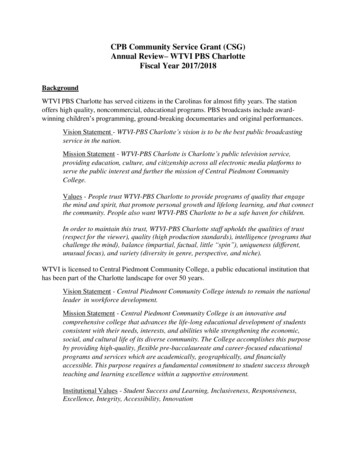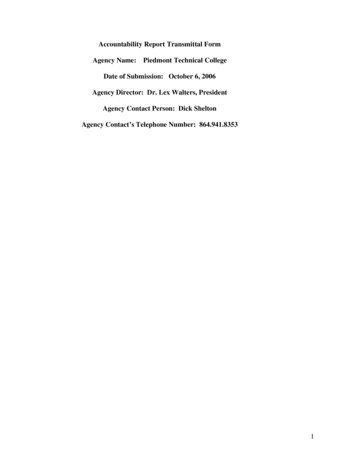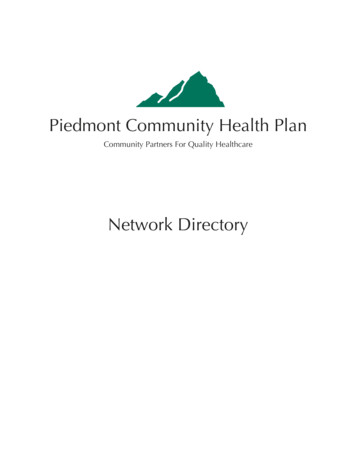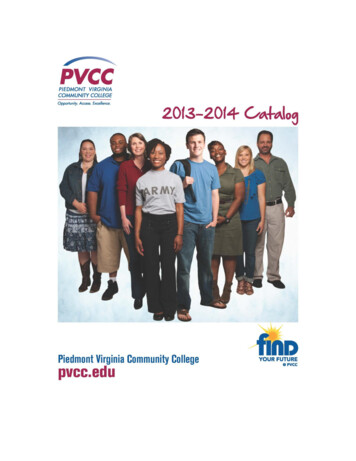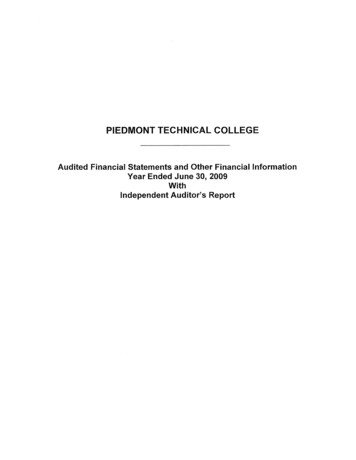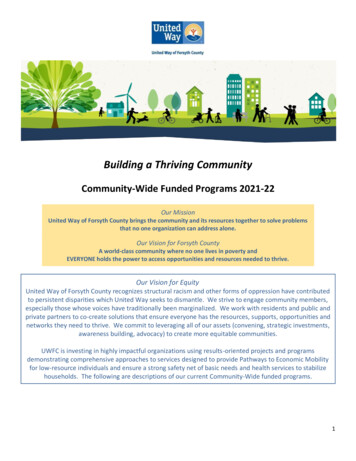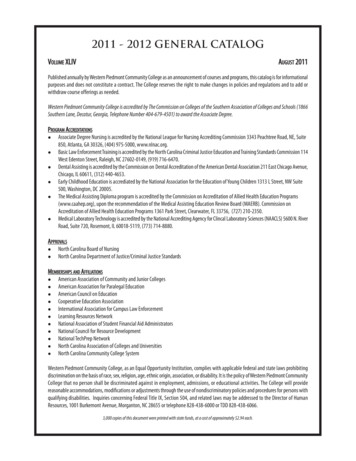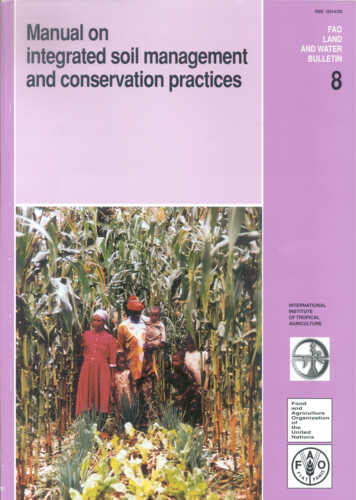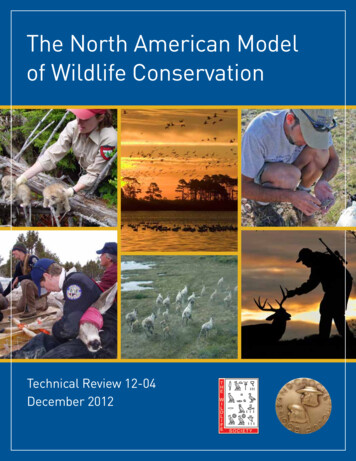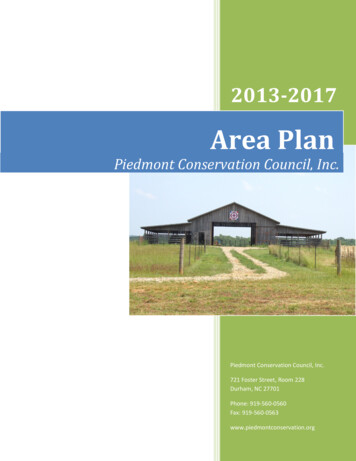
Transcription
2013-2017Area PlanPiedmont Conservation Council, Inc.Piedmont Conservation Council, Inc.721 Foster Street, Room 228Durham, NC 27701Phone: 919-560-0560Fax: 919-560-0563www.piedmontconservation.org
Table of ContentsIntroduction . 4PCC Location and General Information. 5Vicinity Map . 5What is Piedmont Conservation Council RC&D. 5Background and Council Structure . 6The Area Plan Process. 7Public Input Process . 8General Area Description . 9PCC Area Demographics . 9PCC Area Agricultural Resources .13PCC Needs and Opportunities .16Population Increase and Urbanization .16Rural Economic Decline .18Agricultural Shifts .19RC&D Resource Concern Areas .20Land & Water Management .20Forests .20Wetlands .20Water Resources .21Fish and Wildlife .22Community Development .24Poverty and Unemployment .25Distressed Communities.26Workforce Changes .26Land Management .27Energy Conservation and Alternative Fuels .27Sustainable Agriculture and Business Development .28PCC Public Online Survey .31PCC Goals, Objectives, and Strategies . 37Area Plan Linkages to USDA/NCRS Strategic Plan .373
Land Conservation Element .39Water Management Element .40Land Management Element .42Community Development Element .43Signature Page . 45GraphsGraph 1: Central Piedmont Population Increase.10Graph 2: Central Piedmont Population Density .11Graph 3: Population Distribution .13Graph 4: Number of Farms in Central Piedmont .14Graph 5: Average Farm Size .14Graph 6: Agricultural Receipts.15TablesTable 1: Central Piedmont Population Diversity of North Carolina .11Table 2: Importance of Environmental Issues .31Table 3: Feedback on PCC-Provided Services .34Table 4: Demographic Characteristics .354
INTRODUCTIONAccording to the National Association of Resource Conservation and DevelopmentCouncils (NARC&DC), the role of Resource Conservation and Development (RC&D) councils is to“identify, address and solve challenges to sustain and improve quality of life in their owncommunities. By working together on local RC&D Councils; communities, all levels ofGovernment, and grassroots organizations work together to develop and implement solutionsto widespread problems and to develop opportunities that will help sustain rural communities,local economies, and natural resources.”Piedmont Conservation Council, Inc. is an all-volunteer organization that accomplishesits goals and objectives by bringing together and leveraging needed resources to get the jobdone. The strength of the RC&D model is in giving local people the opportunity to solve theirown problems. Piedmont Conservation Council, Inc. (PCC) effectively develops partnershipswith public and private organizations. These alliances provide PCC with the tools to accomplishits goals and objectives. PCC programs and activities are directed by its Board of Directors andimplemented by its members and other partners and volunteers.5
PCC LOCATION AND GENERAL INFORMATIONCounties:The RC&D region includes Alamance, Caswell,Chatham,Durham,Guilford,Orange,Randolph, Rockingham and Wake Counties.Sponsors:Rockingham SWCD, Guilford SWCD, RandolphSWCD, Caswell SWCD, Alamance SWCD,Chatham SWCD, Durham SWCD, Orange SWCD, Town of Franklinville, Piedmont LandConservancy, Chatham County Conservation Partnership, Guilford County Open SpaceCommittee, Piedmont Triad Council of Governments, Dan River Basin Association, and HawRiver Corridor ProjectWhat is Piedmont Conservation Council RC&D?PCC is an independent, non partisan, non profit organization that is community based andregionally focused.PCC Vision“Leveraging people and resources for innovative community and conservation projectsthroughout the Piedmont Region”PCC Mission“We will protect and preserve our natural environment while enriching the quality ofcommunity life.”Background and Council StructurePCC was established in 1967, authorized by Congress in October of 1968, incorporated in 1986,and received 501(c)(3) status in March of 1987. PCC is a not for profit organization thataddresses natural resource conservation and development issues in the eight central Piedmontcounties of Alamance, Caswell, Chatham, Durham, Guilford, Orange, Randolph, Rockingham andWake Counties.6
The Council is made up entirely of volunteers who wish to bring about opportunities to helpcommunities develop innovative solutions for natural resource management. Members of theCouncil are representatives of county leadership, planning departments, soil and water districts,natural resource practitioners, and concerned citizens.7
THE AREA PLAN PROCESSThe Area Plan serves as a strategic plan for the RC&D Area for a five-year period. The plandocuments the goals the Council wants to accomplish through the RC&D Program for the fiveyear time period based on well-defined needs and opportunities.The purpose of PCC’s Area Plan is to identify the natural resource challenges and opportunitiesthroughout the region and determine the most effective ways to identify possible projectsolutions to guide the strategies of resource conservation and community development over thenext five years.PCC depends upon community leaders to provide direction and vision toidentify and address the area's needs. Every five years PCC’s Board of Directors outlines theCouncil’s driving vision in the form of an Area Plan. This document lays out the framework for afive year working business plan through a series of selected goals and objectives.These resource challenges and opportunities were chosen by the full council based oncommunity needs and issues as researched by NC Division of Water Quality BasinwideManagement Plans, Nature Conservancy Ecoregional Plan, NC Wildlife Action Plan, NRCS NaturalResource Inventory, and the Governor’s Task Force on Forest Sustainability. These needs andissues were developed into a grouping of opportunities and services to be addressed andprovided by PCC that align with the RC&D program elements of Land Conservation, WaterManagement, Community Development, and Land Management. These opportunities andservices were then submitted to the public to define and develop priorities for PCC goals andobjectives. The solicitation of public opinion ensures that broad-based support was explored toestablish priorities.Public Input Process:Because the RC&D is a hybrid private and public entity, it can receive both private and publicfinancial support for Council projects. Therefore, the planning process is a collaborative effortthat encourages public input through partnerships among county, town, and city governments,non-profit organizations, and private enterprise. PCC conducted a public survey to solicitopinions and priority levels of private citizens in the PCC area using the latest technology ofQualtrics that administered and summarized the results via an internet based survey thatcould be accessed via a link sent out on email and a link placed on public websites. Over 700emails were sent to citizens, neighbors, partner organizations, their affiliate partners, schoolsystems, natural resource and community non-profits, and local universities. A link to thesurvey was placed on three public websites which included Guilford County Audobon society,Chatham County Community Conservation Partnership, and the Durham Soil and WaterConservation District. The Caswell County News also ran a link to the survey. Citizens fromeach of the eight counties in PCC participated in the survey.8
This plan addresses community-prioritized concerns and needs, and presents the Council’s 5year goals, objectives and strategies to address these concerns and issues under the followingRC&D program elements: Land Conservation: erosion and sediment control Water Management: water use, quality, supply, conservation, flood control Community Development: resource-based business promotion, recreation facilityimprovement, economic development, education promotion Land Management: energy conservation, bio fuels, farm land preservation, fish &wildlife habitat protection9
GENERAL AREA DESCRIPTIONPiedmont Conservation Council encompasses an eight county region in the central to northernPiedmont of North Carolina. The area is economically, geographically, and environmentallydiverse. The Piedmont, or central portion of the state, is a plateau of rolling hills with a range inelevation of 150 to 1,000 feet. This region includes about two-fifths of the area of the state. 1North Carolina has historically been a rural state, with most of the population living on farmsand in small towns. However, over the last 30 years the state has experienced rapidurbanization and sub-urbanization. The Piedmont region has been especially transformed alongthe major transportation corridors of Interstate 40 and Interstate 85.PCC Area Demographics:North Carolina saw a 16.5% increase in population between 2000 and 2009, according to USCensus Bureau population estimates 2. According to the North Carolina Rural Center thePiedmont Region had the largest population increase of any of the three physiographicprovinces in North Carolina 3 .“Population growth from 1990 to 2000was dominated by migration. Netmigration, the number of people whomoved to North Carolina minus thenumber who left, accounted for 70percent of the population increase, ormore than 1 million new residents.” 4Since 1950, the state's population hasincreased by 63%. 5 Because highpopulation densities correspond withhigh resource use, it is important to understand where North Carolinians live. 611997 Natural Resources Inventory of North Carolina2US Census Bureau3NC Rural Center Rural Data Bank4NC Rural Center Rural Data Bank51997 Natural Resources Inventory of North Carolina61997 Natural Resources Inventory of North Carolina10
Guilford, Alamance, Durham, and Orange Counties have harbored the bulk of the growth inPCC’s eight county region. Some of the counties are experiencing rapid transition frompredominantly rural communities to more suburban landscapes as bedroom communitiesextend from the urban sectors of Greensboro and Raleigh/Durham/Chapel Hill (referred tothroughout as the Research Triangle) into nearby rural areas where cheaper land prices exist.Chatham County has experienced the most rapid growth since 2000 of any of the eight countiesin PCC’s region. Durham also exceeds the state average for population growth and density (SeeGraphs 1 and 2 below).Population Increase in Central Piedmont of NorthCarolina, 2000 - kinghamCaswell-5%0%5%State Average10%15%20%Percentage Growth25%30%35%Graph 1: Central Piedmont Population IncreasePopulation trends in Chatham and Durham counties exceed the state average. In fact, ChathamCounty growth is approximately twice as high as North Carolina. It will be important for PCC tofocus on conservation efforts in these two counties. As more residents use more resources, it isincreasingly important to mitigate the negative effects of population growth. However, thisgrowth trend should not cause alarm at this point. As shown in Graph 2, the population densityin Chatham is relatively low. On average there are 95 persons per square mile. When this figureis compared with Durham’s density of 943 persons per square mile, the population growth inChatham does not warrant as much attention as that of Durham County. The already highpopulation density in Durham combined with the growing population suggests that effortsshould be focused on conserving natural resources and social welfare in this county.11
Population Density for Central Piedmont ofNorth Carolina, 2009 ndolph181Rockingham163Chatham95Caswell540State Average100200300400500600Persons Per Square Mile7008009001000Graph 2: Central Piedmont Population DensityFour counties in PCC’s region have greater population density than the state average: Durham,Guilford, Alamance, and Orange. Population density is a good indicator for PCC attention; thegreater the number of people the larger the threat of negative impacts on the environment.Therefore, in order to make the greatest impact on benefits to the entire region, PCC shouldallot time and resources relative to population density. In this case, Durham County should begiven higher priority especially considering the compounding factor of significant populationgrowth.As stated earlier, PCC serves a very diverse population. The more urban counties have higherpercentages of ethnic/racial diversity. See Table 1 below.Table 1: Central Piedmont Population Diversity of North Carolina 7Total Population% Black% Hispanic% White% OtherNorth Alamance142,66118.0%10.7%68.4%2.9%72006 U.S. Census Bureau12
Total Population% Black% Hispanic% White% %1.8%61.1%0.3%13
PCC Area Agricultural Resources:Randolph County has the most individual farms (see Graph 3) of any other county inPCC’s eight county region and also has the largest amounts of agricultural receipts. However,Caswell County has the largest average farm size and is the only county with an average farmsize larger than the state average of North Carolina.Total Number of Farms in Central Piedmont of NC, 008001000120014001600Number of FarmsGraph 3: Population Distribution14
Individual Farms in Central Piedmont of North Carolina, 060080010001200140016001800Number of FarmsGraph 4: Number of Farms in Central PiedmontAverage Farm Sizes in Central Piedmont of North Carolina, State Average175200225250AcreageGraph 5: Average Farm Size15
Agricultural Receipts in Central Piedmont of NC, 2007Randolph 206Chatham 172Guilford 48Alamance 43Rockingham 32Orange 28Caswell 21 0 50 100 150 200 250Total Receipts (in millions)Graph 6: Agricultural Receipts16
PCC NEEDS AND OPPORTUNITIESPopulation Increase and Urbanization“Urbanization and development are a mixed blessing. From an economic perspective,development means more jobs, enhanced business opportunities, and an expanded tax base.However, development increases pressures on natural resources. Resource depletion, pollution,and use-conflicts increase with population density.” 8 Areas with high projected populationgrowth can expect considerable land use change. More agricultural land is expected to beconverted to suburban development or commercial and industrial use.Areas experiencing population growth also experience water quality impairments. “As landareas urbanize, stream ecosystems can be substantially altered. Changes in the landscape as awatershed urbanizes may cause changes in stream hydrology, water quality, physical habitat,and water temperature that are known to have profound effects on aquatic communities ofalgae, invertebrate and fish. Understanding these interrelationships may contribute to informeddecisions that result in practical and effective water-resource management and strategies thatprotect and restore stream ecosystems.” 9 Water quality impairments include a dramaticincrease in sedimentation from land clearing activities for new construction and increased pointsource discharges from municipal sewage treatment plants. Population growth is expected tohave a substantial impact on non-point source loading as well, specifically total phosphorus, oiland grease, and heavy metals. Future growth also threatens the quantity of water supplysources. In some way, every person, industry, landowner and municipality in the basin impactswater quality. Therefore, every resident of the basin should play a role in managementstrategies designed to protect and restore the streams, lakes and rivers of the basin. 10“The waters of the Cape Fear River basin where Guilford, Alamance, and parts of Orange andDurham counties are located are nutrient sensitive, meaning excessive growths of microscopicor macroscopic vegetation is occurring in downstream reservoirs due to nutrient overloads fromnitrogen or phosphorous. Excessive growth is considered that which substantially impairs theuse of the water for its best usage as determined by the state's water classification system. Themost polluted basin in North Carolina, however, is the Neuse River basin, where Wake, Orange,81997 Natural Resources Inventory of North Carolina9Giddings, E.M., Moorman, M., Cuffney, T.F., McMahon, Gerard, and Harned, D.A., 2007, Selectedphysical, chemical, and biological data for 30 urbanizing streams in the North Carolina Piedmontecoregion, 2002–2003: U.S. Geological Survey Data Series 279, 008/documents/ExecutiveSummary.pdf17
and Durham counties are located. Urban stormwater, and agricultural and constructionactivities all contribute to the problem in the form of nonpoint source pollutants. Point sourcesfrom industry and wastewater treatment plants also contribute. This has resulted in the entireNeuse basin being declared nutrient sensitive.” 11Urbanization and paving can have a severe effect on stream aquatic life. Studies by theMaryland Department of Natural Resources stated that a reduction in stream aquatic speciesdiversity may begin with as little as 2% impervious cover. 12 Maryland streams with above 15%impervious cover were rated fair to poor for aquatic species. When the impervious coverreached 25%, species diversity was significantly reduced. Riparian vegetation removal andpaving affect both stream water temperature and habitat for aquatic species. Organisms mostaffected include many species of reptiles and amphibians, brook trout, and stoneflies.Stormwater runoff from paved areas can also wash out oil and grease and other pollutants intostreams. The paved areas also restrict replenishment of groundwater and contribute to flashflooding during storm events and extreme fluctuations in stream water levels. Extreme flowfluctuations cause difficulties in the attachment of bottom dwelling organisms to the streamsubstrate and also cause a scouring of the substrate. Retention of riparian vegetation inunnamed headwater tributaries, known as first order streams, which may comprise as much as50% of the streams in a watershed, can be especially critical to the protection of organisms inthe downstream watershed.Forest fragmentation is on the rise. 13 Wildlife species dependent on interior forest habitats willcontinue to decline in the Piedmont as urbanization and population increases decrease parcelsize and take large acres of forest and convert them into residential neighborhoods, parks, orcommercial/industrial facilities. Forest fragmentation is thought to be a contributing factor tothe decline in certain neotropical populations. 14Many species are also sensitive to road density for terrestrial migrations for food andreproduction. Furthermore, soil erosion and water pollution may increase in North Carolina'swatersheds as forest fragmentation becomes more prevalent, depending on how landconversions and land-disturbing activities are conducted. It is also economically more difficultto produce and harvest timber on fragmented lands using current forestry practices and111997 Natural Resources Inventory of North Carolina12Maryland Department of Natural Resources and Pennsylvania Department of Environmental Protection“Watershed Restoration Action Strategy”13North Carolina Report of the Governor's Task Force on Forest Sustainability. 1996141997 Natural Resources Inventory of North Carolina18
techniques. Durham County is the most densely populated, followed by Guilford County,Alamance and Orange County. Caswell County has the lowest population density in PCC’s Area.“As the urban/rural interface shifts, some species of wildlife adapt to living within closeproximity to humans. Deer, raccoons, opossums, squirrels, and rabbits are species mostcommonly seen around urban and residential areas. Urban residents attract numerous birdspecies to feeders and wildlife-friendly landscaped yards. However, interactions betweenwildlife and humans are not always beneficial, as evidenced by the rapid rise in deer/autocollisions and rabies cases reported across the state.” 15Not all wildlife adapt to habitat modifications designed to meet human needs. North Carolinahas lost critical habitat and consequently has 64 plant or animal species on the FederalEndangered and Threatened Species list.Rural Economic Decline:North Carolina has experienced a tremendous shift in its historic economic drivers. Thebackbone of much of the state’s economic success has been textile manufacturing and tobacco.Both of these economies have disappeared over the last decade leaving many small townsstruggling to find an economy that adequately fills the gaps left by the absence of manufacturingjobs and the cash crop of tobacco. Urban centers like Greensboro and the Research Trianglehave more diverse economies. As a result they have the capacity to weather the economicdownturn and hardships brought on by globalization. Many of the smaller cities and smalltowns are not so lucky. Small towns have traditionally depended upon single market economieswhere one or two manufacturing companies employ the majority of their workforce and keepthe local economies vibrant. Many small towns were hit hard throughout the 1990s asmanufacturing dried up and most of the rural south has yet to experience a recovery nearly adecade into the 21st Century. Durham, Chapel Hill, Greensboro, and Burlington have also reliedon their proximity to major universities to maintain economic flexibility.As the population ages in the Piedmont much of the youth has chosen to reside in the urbancenters as opposed to more rural areas due to the proximity of job opportunities and activity.This puts a brain drain on rural areas and few communities are able to replace aging leadershipwith younger, civically responsible and creative citizens to combat economic hardship andmounting development pressures. Farmland loss continues at a quickening pace as the youngergenerations leave agriculture and the family farm for the urban economies. Most rural farms onthe fringe of these urban landscapes have land values that are worth more divided and sold intolots than they are producing commodities.151997 Natural Resources Inventory of North Carolina19
Agricultural Shifts:Agriculture has historically been a vital sector in North Carolina’s economy and it remains sotoday. However, the industry is changing. As evidenced in the agricultural description, thenumber of farms is declining as small farmers are edged out of the market. As families moveaway from farming, there is a trend for movement back to the cities, which puts even morestress on the resources available in cities. Therefore, it is important for PCC to focus onpreservation of agriculture.Families are leaving farming for several reasons, but one of the most powerful forces is thatproperty values exceed revenue in most cases. Foreign markets, regulatory pressures, andnatural disasters are also factors. Commodity prices are much lower than what they were in the1950s which means that only large operations that produce mass quantities can remaineconomically viable.16Thus, farmers must adapt in order to remain competitive in the global market. Finding nichemarkets, such as organics and local farmer’s markets, can help farmers avoid the negativeeffects of the agricultural shift. In addition, it is important for local governments to make effortstoward retaining agricultural land. With support from governments and organizations like thePCC, farming can remain part of the North Carolina landscape.16National Agriculture Statistics Service, http://www.nass.usda.gov/20
RC&D RESOURCE CONCERN AREASThe purpose of this section is to define a comprehensive understanding of the issues, trends,and conditions of natural and human resources within the designated PCC Area.Land & Water ManagementThe state of North Carolina is approximately 84% privately owned 17, thus private landownersplay a most important role in determining the fate of the state’s natural resources.Forests:“North Carolina forests consist of more than 180 tree species, of which one third havecommercial value. North Carolina forests have economic, ecological, recreational, and aestheticvalue. Standing timber in North Carolina is worth an estimated 19 billion. In addition to thedirectly measurable value that forests give to the state, there are many additional benefits thatcannot be quantified. Forests provide habitat for game and nongame species of wildlife, recyclenutrients, and contribute to the development of fertile soils through the decomposition oforganic matter, and minimize soil erosion. Most importantly perhaps, forests provide clean airand water by filtering pollutants and other impurities from the environment. Only 55% of theland area in the Piedmont is wooded. Urbanization, agriculture, and small public holdings makeit the least forested region in the state.” 18With talk of emerging ecosystem payment systems, North Carolina residents may be able tobenefit financially from the private land they own. Nonindustrial
2013-2017 . Area Plan . Piedmont Conservation Council, Inc. Piedmont Conservation Council, Inc. 721 Foster Street, Room 228 Durham, NC 27701 . Phone: 919-560-0560
